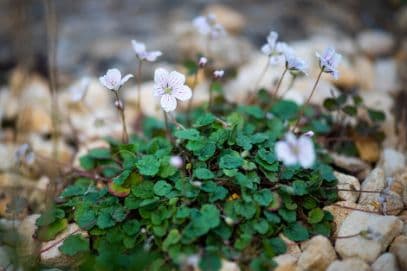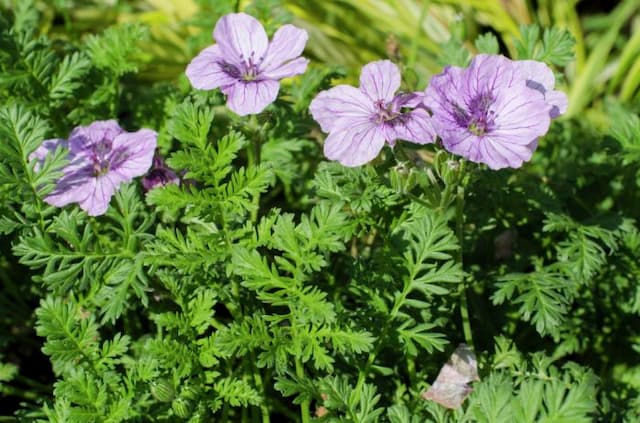Cambridge Geranium Geranium × cantabrigiense 'Westray' (PBR)

ABOUT
The Geranium × cantabrigiense 'Westray' is a variant from the Geranium family known for its alluring ornamental features. Typically referred to as a hardy geranium or cranesbill, this plant exhibits a lush, semi-evergreen foliage that exudes a quintessential charm. The leaves are rounded, displaying a rich green hue, often with a hint of marbling or veining which adds texture and depth. Seasonal changes may coax the foliage to a reddish tone, providing an added spectacle of color. The blossoms of the 'Westray' are particularly striking. They emerge in clusters, blanketing the foliage from late spring into midsummer, with sporadic blooms that may reappear through the growing season. The flowers boast an uplifting, vivacious pink with deeper magenta veins radiating from the center, which create a dramatic contrast against the backdrop of the green leaves. Each flower consists of rounded petals that are slightly cupped, lending a sense of softness and delicacy to the overall appearance of the plant. As is characteristic of the hardy geraniums, 'Westray' is noted for its durability and resistance, capably enduring a variety of growing conditions. While the specific dimensions of this variety are omitted, the plant is well-regarded for its ground-covering abilities, forming a dense mat that serves as both an aesthetic and functional garden feature. This cranesbill geranium is cherished by garden enthusiasts for its vibrant blooms, textured foliage, and reliability in landscaping.
About this plant
 Names
NamesSynonyms
Cambridge Geranium, Cantabrigian Cranesbill.
Common names
Geranium × cantabrigiense 'Westray' (PBR).
 Toxicity
ToxicityTo humans
The Cambridge geranium, generally known in horticulture as Geranium × cantabrigiense, is not considered toxic to humans. There are no well-documented cases of poisoning in humans from ingesting this plant, and it is typically deemed safe around children and adults. However, as with any plant material, ingestion may cause discomfort or adverse reactions in some individuals, such as minor gastrointestinal upset. It’s always best to avoid eating plants that are not explicitly meant for consumption.
To pets
The Cambridge geranium is also not known to be toxic to pets including dogs and cats. While it is not common for pets to suffer from poisoning after ingesting this plant, it's always prudent to keep an eye on your pets and discourage them from eating ornamental plants. In the rare case of ingestion, keep an eye out for any signs of gastrointestinal upset and contact your vet if you observe any unusual behavior.
 Characteristics
CharacteristicsLife cycle
Perennials
Foliage type
Evergreen
Color of leaves
Green
Flower color
Pink
Height
0.5 feet (15 cm)
Spread
1.5 feet (45 cm)
Plant type
Herb
Hardiness zones
5
Native area
Europe
Benefits
 General Benefits
General Benefits- Easy to maintain: Geranium × cantabrigiense 'Westray' is a low-maintenance plant that requires minimal care once established, making it ideal for gardeners of all skill levels.
- Drought tolerant: Once established, this geranium is relatively drought tolerant, reducing the need for frequent watering.
- Ground cover: Its dense growth habit makes it an excellent ground cover, helping to suppress weeds and protect the soil from erosion.
- Attracts pollinators: The flowers of the plant attract bees, butterflies, and other beneficial insects, promoting biodiversity in the garden.
- Long flowering period: It boasts a long blooming season, providing colorful flowers from late spring to early summer.
- Deer resistant: The foliage is generally unpalatable to deer, making it a good choice for gardens in areas with deer populations.
- Aesthetic appeal: With its attractive foliage and vibrant flowers, this geranium can enhance the visual appeal of any garden or landscape.
- Hardy: It is a hardy plant that can withstand cold temperatures, making it suitable for a variety of climates.
 Medical Properties
Medical PropertiesThis plant is not used for medical purposes.
 Air-purifying Qualities
Air-purifying QualitiesThis plant is not specifically known for air purifying qualities.
 Other Uses
Other Uses- Culinary Garnish: The Cambridge geranium's delicate flowers can be used to add a splash of color to salads or as an edible garnish on various dishes.
- Pressed Flower Crafts: The petals of the Cambridge geranium can be pressed and used in crafting, such as in homemade cards, bookmarks, or framed botanical art.
- Natural Dye: The flowers and leaves of the Cambridge geranium can be boiled to create a natural dye for fabrics or paper.
- Scented Drawer Liners: Dried Cambridge geranium leaves can be used to make natural scented drawer liners, providing a gentle fragrance to clothing and linens.
- Photography Prop: The plant can serve as a photogenic subject or a backdrop for macro photography and nature-inspired still life compositions.
- Educational Tool: In schools, the plant can be used to teach children about plant biology, life cycles, and the importance of pollinators in gardens.
- Companion Planting: Cambridge geranium can be used in companion planting to attract beneficial insects or as a ground cover to suppress weeds in gardens.
- Soil Erosion Control: This plant's ability to spread and form dense mats makes it an effective tool in stabilizing soil and preventing erosion on slopes.
- Flavor Infusing: Leaves of the Cambridge geranium can be infused into syrups, sugars, or teas to impart a subtle flavor and aroma to culinary creations.
- Wedding Decor: Fresh or dried, Cambridge geranium flowers can add natural elegance to wedding bouquets, centerpieces, or venue decorations.
Interesting Facts
 Feng Shui
Feng ShuiThe Cambridge Geranium is not used in Feng Shui practice.
 Zodiac Sign Compitability
Zodiac Sign CompitabilityThe Cambridge Geranium is not used in astrology practice.
 Plant Symbolism
Plant Symbolism- Unity: Geraniums often symbolize togetherness or unity, which can be attributed to their clustered flowers and habit of growing in tight bunches.
- True Friendship: They are known to represent true friendship due to their long-lasting nature, making them excellent gifts between friends.
- Comfort: The comforting and pleasing aroma of geranium leaves can represent solace and comfort in times of stress.
- Fertility: Some cultures associate geraniums with fertility and reproduction because they are robust plants that propagate easily.
- Good Health: Their medicinal uses in some traditions have led to associations with overall good health and well-being.
- Positive Vibes: With their bright and cheerful flowers, geraniums are often seen as a symbol of positivity and cheerfulness.
- Stalwartness: They are resilient and can represent strength of character and steadfastness, flourishing even in challenging environments.
 Water
WaterCambridge Geranium prefers consistently moist soil, but it's important to avoid overwatering. During the growing season, water thoroughly once a week, allowing the soil to dry out slightly between waterings. In hotter, drier periods, you may need to water twice a week. Each watering session should provide enough water to soak the soil to a depth of about an inch. A good guideline is to use about half a gallon per plant per watering session, depending on the size of the plant and environmental conditions.
 Light
LightCambridge Geranium thrives in full to partial sun. The ideal spot for this plant is an area that receives several hours of sunlight daily, but it can also tolerate some shade. Avoid placing it in a location that gets intense, hot afternoon sun, as this might stress the plant.
 Temperature
TemperatureCambridge Geranium can tolerate a wide range of temperatures but performs best between 60°F and 75°F. They can survive in temperatures as low as 20°F, but frost and freezing conditions can damage or kill the plant. During hot summer days, they appreciate cooler night temperatures.
 Pruning
PruningCambridge Geranium benefits from occasional pruning to encourage bushier growth and more flowers. Prune lightly after the first flush of flowers to stimulate a second blooming. The best time for pruning is in late summer or early fall before the plant goes dormant.
 Cleaning
CleaningAs needed
 Soil
SoilThe Cambridge Geranium thrives in well-draining soil enriched with organic matter, such as a mix of loam, peat, and perlite or sand. The ideal soil pH for the Cambridge Geranium should be slightly acidic to neutral, ranging from 5.8 to 7.2.
 Repotting
RepottingThe Cambridge Geranium typically doesn't require frequent repotting and can be done every 2 to 3 years or when the plant has outgrown its current container.
 Humidity & Misting
Humidity & MistingThe Cambridge Geranium prefers moderate humidity levels but is quite adaptable and can tolerate the drier conditions typically found in most home environments.
 Suitable locations
Suitable locationsIndoor
Place in bright, indirect light and ensure good air circulation.
Outdoor
Plant in partial shade, protect from intense afternoon sun.
Hardiness zone
5-8 USDA
 Life cycle
Life cycleThis variety of Cranesbill, or Geranium × cantabrigiense 'Westray', begins its life cycle as a seed, which upon germination develops into a small seedling. The seedling stage is characterized by the initial growth of roots and leaves as it establishes itself. Following the seedling stage, the plant enters a vegetative phase where it grows vigorously, producing a rosette of leaves along with dense, mat-forming foliage that is characteristic of this perennial. As it matures, the Cranesbill progresses to the flowering stage, typically in late spring to early summer, producing vibrant pink to purplish flowers with veining that attract pollinators. After pollination, the plant sets seed, and these seeds can either drop nearby to propagate new plants or be collected for planting elsewhere. During autumn and winter, the plant may die back, entering a period of dormancy, but its root system remains alive to regrow when conditions become favorable in the following spring.
 Propogation
PropogationPropogation time
Spring-Early Summer
The Geranium × cantabrigiense 'Westray', commonly known as Cambridge geranium, can be propagated most effectively through division, which is best carried out in spring or early fall. To propagate by division, carefully lift the parent plant from the ground with a shovel and gently shake off excess soil to reveal the root ball. Look for natural divisions in the root structure where the plant has formed distinct clumps. Using a sharp knife or spade, cut between these clumps to separate them into smaller sections, ensuring that each new section has a portion of the root system and several shoots. Replant the divisions at the same depth they were growing previously, spacing them about 12 to 15 inches (30 to 38 centimeters) apart to allow room for growth. Water the newly planted divisions well to establish them. This method of propagation allows gardeners to quickly increase their stock of Cambridge geranium while maintaining the genetic integrity of the 'Westray' cultivar.




![Cranesbill [Blue Sunrise]](/_next/image?url=https%3A%2F%2Fplants-admin.emdemapps.com%2Fimages%2Fplants%2F%2Fimages%2F604b638d45948.png&w=640&q=75)




